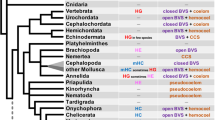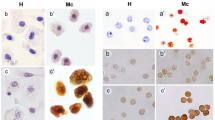Abstract
The iron-containing protein neuroglobin (Ngb) involved in the transport of oxygen is generally considered the precursor of all animal globins. In this report, we studied the structure of Ngb of the cold-water sponge Halisarca dujardinii. In sponges, the oldest multicellular organisms, the Ngb gene contains three introns. In contrast to human Ngb, its promoter contains a TATA-box, rather than CG-rich motifs. In sponges, Ngb consists of 169 amino acids showing rather low similarity with its mammalian orthologues. It lacks Glu and Arg residues in positions required for prevention of hypoxia-related apoptosis. Nevertheless, Ngb contains both proximal and distal conserved heme-biding histidines. The primary structure of H. dujardinii neuroglobin predicted by sequencing was confirmed by mass-spectrometry analysis of recombinant Ngb expressed in E. coli. The high level of Ngb expression in sponge tissues suggests its possible involvement in the gas metabolism and presumably in other key metabolic processes in H. dujardinii.

Similar content being viewed by others
REFERENCES
Burmester T., Weich B., Reinhardt S., Hankeln T. 2000. A vertebrate globin expressed in the brain. Nature. 407, 520–523.
Burmester T., Gerlach F., Hankeln T. 2007. Regulation and role of neuroglobin and cytoglobin under hypoxia. Adv. Exp. Med. Biol.618, 169–180.
Li W., Wu Y., Ren C., Lu Y., Gao Y., Zheng X., Zhang C. 2011. The activity of recombinant human neuroglobin as an antioxidant and free radical scavenger. Proteins.79, 115–125.
Brittain T., Skommer J., Henty K., Birch N., Raychaudhuri S. 2010. A role for human neuroglobin in apoptosis. IUBMB Life.62, 878–885.
Tiso M., Tejero J., Basu S., Azarov I., Wang X., Simplaceanu V., Frizzell S., Jayaraman T., Geary L., Shapiro C., Ho C., Shiva S., Kim-Shapiro D.B., Gladwin M.T. 2011. Human neuroglobin functions as a redoxregulated nitrite reductase. J. Biol. Chem.286, 18277–18289.
Lechauve C., Augustin S., Cwerman-Thibault H., Bouaita A., Forster V., Célier C., Rustin P., Marden M.C., Sahel J.A., Corral-Debrinski M. 2012. Neuroglobin involvement in respiratory chain function and retinal ganglion cell integrity. Biochim. Biophys. Acta.1823, 2261–2273.
Pesce A., Dewilde S., Nardini M., Moens L., Ascenzi P., Hankeln T., Burmester T., Bolognesi M. 2003. Human brain neuroglobin structure reveals a distinct mode of controlling oxygen affinity. Structure. 11, 1087‒1095.
Vallone B., Nienhaus K., Brunori M., Nienhaus G.U. 2004. The structure of murine neuroglobin: Novel pathways for ligand migration and binding. Proteins. 56, 1087‒1095.
Lechauve C., Jager M., Laguerre L., Kiger L., Correc G., Leroux C., Vinogradov S., Czjzek M., Marden M.C., Bailly X. 2013. Neuroglobins, pivotal proteins associated with emerging neural systems and precursors of metazoan globin diversity. J. Biol. Chem.8, 6957‒6967.
Casado B., Pannell L.K., Whalen G., Clauw D.J., Baraniuk J.N. 2005. Human neuroglobin protein in cerebrospinal fluid. Proteome Sci.3, 2.
Wakasugi K., Takahashi N., Uchida H., Watanabe S. 2011. Species-specific functional evolution of neuroglobin. Mar. Genomics.4, 137‒142.
Grabherr M.G., Haas B.J., Yassour M., Levin J.Z., Thompson D.A., Amit I., Adiconis X., Fan L., Raychowdhury R., Zeng Q., Chen Z., Mauceli E., Hacohen N., Gnirke A., Rhind N., et al. 2011. Full-length transcriptome assembly from RNA-Seq data without a reference genome. Nat. Biotechnol. 29, 644–652.
McCarthy D.J., Chen Y., Smyth G.K. 2012. Differential expression analysis of multifactor RNA-Seq experiments with respect to biological variation. Nucleic Acids Res.40, 4288–4297.
Schmidt W.M., Mueller M.W. 2012. CapSelect: A highly sensitive method for 5' CAP-dependent enrichment of full-length cDNA in PCR-mediated analysis of mRNAs. Nucleic Acids Res. 27, e31.
Matz M., Shagin D., Bogdanova E., Britanova O., Lukyanov S., Diatchenko L., Chenchik A. 1999. Amplification of cDNA ends based on template-switching effect and step-out PCR. Nucleic Acids Res.27, 1558–1560.
Bonchuk A., Denisov S., Georgiev P., Maksimenko O. 2011. Drosophila BTB/POZ domains of “ttk group” can form multimers and selectively interact with each other. J. Mol. Biol.412, 423‒436.
Zhang W., Tian Z., Sha S., Cheng L.Y., Philipsen S., Tan-Un K.C. 2011. Functional and sequence analysis of human neuroglobin gene promoter region. Biochim. Biophys. Acta. 1809, 236‒244.
Smale S.T., Kadonaga J.T. 2003. The RNA polymerase II core promoter. Annu. Rev. Biochem.72, 449‒479.
Dröge J., Pande A., Englander E.W., Makałowski W. 2012. Comparative genomics of neuroglobin reveals its early origins. PLoS One.7, e47972.
ACKNOWLEDGMENTS
The studies were carried out using the equipment of the Core Centrum of Institute of Developmental Biology RAS. Chromatography-mass spectrometric analysis was performed on the equipment of the Central Scientific-Practical Institute, Institute of Bioorganic Chemistry, Russian Academy of Sciences “New Materials and Technologies.”
Funding
The study was supported by the Russian Foundation for Basic Research (grant No. 19-34-50002). The work of KIA, OIK, ADF, VSM, NGG, and YVL was conducted under the IDB RAS Government basic research program in 2020.
Author information
Authors and Affiliations
Corresponding author
Ethics declarations
Conflict of interest. The authors declare they have no conflict of interest.
Statement on the welfare of animals. All applicable international, national, and/or institutional guidelines for the care and use of animals were followed.
Rights and permissions
About this article
Cite this article
Adameyko, K.I., Kravchuk, O.I., Finoshin, A.D. et al. Structure of Neuroglobin from Cold-Water Sponge Halisarca dujardinii. Mol Biol 54, 416–420 (2020). https://doi.org/10.1134/S0026893320030036
Received:
Revised:
Accepted:
Published:
Issue Date:
DOI: https://doi.org/10.1134/S0026893320030036




